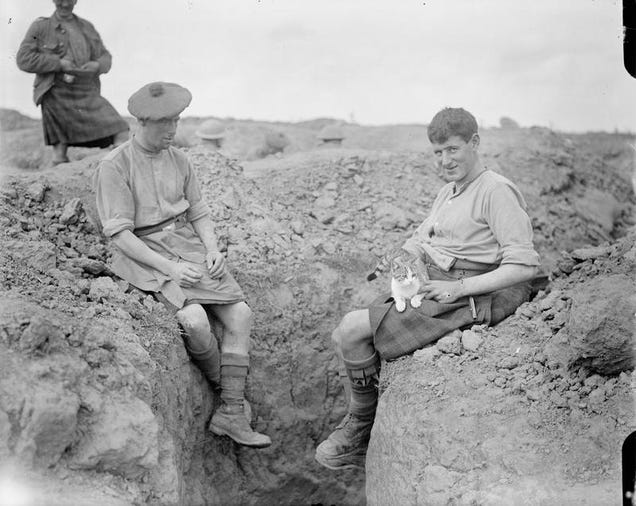As promised, I'm starting a look at the First Battle of the Marne through the eyes of a couple of different boardgames.
This entry contrasts two different treatments by the same designer. As I mentioned, I recently received
the new editions of Ted Racier's two early war operational games, Glory's End and When Eagles Fight. A few brief words on opening that treasure trove follow.

First, the box cover: handsome cover art, a painting entitled
France! 1914 by the French war artist Leon Reni-Mel. It's quite evocative, in its depiction of a young
poilu in the famous
pantalons rouges at the moment of his death, rushing forward in the spirit of French Army's "attack, attack, always attack" doctrine.

The back of the box provides a look at the two major maps it contains, one of the western front (including Belgium, Luxembourg, and bits of France, Germany, and the Netherlands) and one of the eastern front (featuring pieces of Austria-Hungary, Russia, Germany, and Romania). We get a sample of game pieces, a list of contents, and details on game scale. The design, development, and production crew are credited. And the box provides the publisher's assessment of the game's complexity (low-medium) and solitaire suitability (high--luckily for me!)

Inside the box we find the usual high-quality components one expects from GMT Games: rulebooks for both games, two sets of player charts for each games, three and a half sheets of counters (plus the ubiquitous GMT bundle of ziplock bags for counter storage), a mini-map for playing a short scenario of Glory's End, and the main map sheet itself. In a practical move, GMT has printed one sheet, double-sided, for the two games, with western Europe on one side and eastern Europe on the other.

Since my goal was to post a piece on the Marne battle, I was delighted to find the small map with the short, introductory scenario specifically focused on the Marne. I was particularly amused, too, since I had set up the intro scenario from Clash of Giants, which focuses on the exact same moment. Nothing would make it easier to compare the two games that to take a look at the starter's scenario for these two Ted Racier games of the early war on the western front.
Here is a look at the
Clash map, set for "The Allied Counterattack" scenario, which begins as the French and British are about to spring their trap on the advancing Germans. I've provided only a small image, but to the west (left) side of the map, if you squint you can probably see the grey blob that is Paris, wedged in the loops of the Seine River. Around and to the north of it are the troops of the Fortified Camp of Paris, and in a north-south line to the northeast of the city is the advancing French Sixth Army. A few scattered blocks of grey represent the flank guards of the German First Army, most of whose combat troops are committed in the bulge east and south of Paris. The British Expeditionary Force (BEF), a few lonely stacks of khaki counters, screens the gap between the city of Paris and the French Fifth Army under it's newly appointed General Louis Franchet d'Espère. The Fifth faces not only von Kluck's seemingly triumphant German First Army but also von Bulow's Second Army, trying to widen the east side of the German penetration. To von Bulow's east is von Hausen's Third Army, Saxons all, and the screen formed by the scattered Fourth Army, the link to the (unseen Firth Army, battering the walls of Verdun and the Sixth and Seventh, deep in the hills and mountains of the Vosges.
East of the French Fifth Army is the high shoulder formed by the clustered French Ninth Army of the inimitable Ferdinand Foch, future commander in chief. And to their east, facing the German Fourth Army, is France's own Fourth Army, likewise spread thin to maintain contact with forces to the east. The date is the 5th of September, and the solid mass of Michel-Joseph Manoury's Sixth (French) Army is about to give Friedrich Sixt von Arnim's IV Corps a horrid surprise.

Contrast that setup with the same scenario, more or less, in
Glory's End, set up on the mini-map provided with that game (it's the same scale and size of hex as the main
Glory's End map, but easier to set up in a small space). One thing you'll notice right away is that the map covering the same area is much smaller, the counter density higher, while at the same time the overall number of counters is much lower. That's because
Glory's End packs the entire western front into its main map. Each hex is 9.5 miles wide, instead of the 3.3 miles of the
Clash of Giants: Marne map. Most of the units in
Glory's End are corps or corps-sized formations, while
CoG:M units are most of them divisions. (Those three hexes covered with ignominious "Out of Command" markers contain the regrouping forces of the BEF.)
So, that's a quick look at the new title, and a swift visual comparison with another treatment of the same action by the same designer. I have a number of other titles that cover operations on the western front in 1914 (
The Great War in Europe and
Grand Illusion, both also by Ted Racier, and Michael Resch's
1914: Offensive a Outrance), but none of them specifically call out the First Battle of the Marne for scenario treatment. There are half a dozen games that specifically focus on the First Marne, but none of them are in my library, alas.
Next time: that promised letter. And, soon, hopefully, an account of playing through one of these Marne scenarios.










